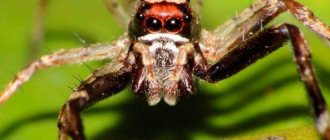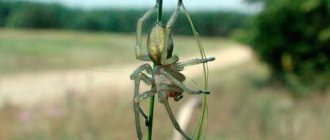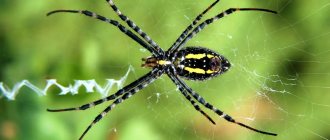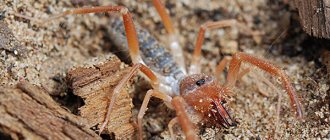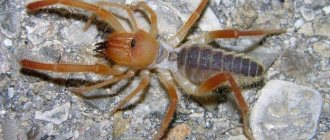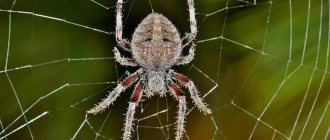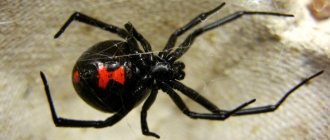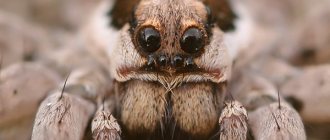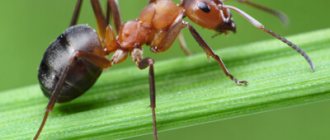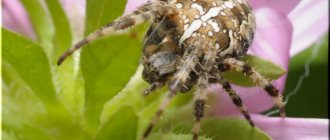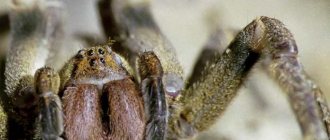Poisonous spiders are found primarily in warm regions of the world. But in Russia there are also some species whose bite causes an acute allergic reaction and even death in humans. It is not always possible to identify poisonous spiders by photo and name. However, these representatives of the order of arthropods do not attack people. Moreover, you can meet such spiders if you often visit nature. At home, these representatives of the fauna can live in cases where there is a food supply (insects).
- How many poisonous spiders are there in the world?
- TOP 10 most poisonous Brazilian soldier spider (Phoneutria)
- funnel web spider
- Six-eyed sand spider
- Black Widow
- Karakurt
- Brown recluse spider
- Tarantula
- Yellow sac spider
- White tail spider
- Mouse spider
- Karakurt
The most dangerous and poisonous spiders in Russia
Almost all spiders are predators. There is only one species that prefers plant foods. Other arachnids hunt other living creatures for food.
Most of them have poisonous glands attached to their fangs. Almost all spiders are poisonous.
Another thing is that the poison of most species is slightly toxic and not dangerous to humans. And the small fangs of some arthropods are not able to bite through the integument of the human body.
That is why, of all the variety of species inhabiting Russia, it is important to know which spiders can pose a danger to humans. Let's look at which spider is the most poisonous in Russia.
Karakurt or black widow
First, let's look at which spiders in Russia are the most poisonous. Scientists believe that these are karakurts, which are also sometimes called black widows. A karakurt bite can lead to human death.
Its poison is especially dangerous for the elderly and children. It lives in areas with a relatively warm climate, although in the summer it may migrate north. Often found in the Black Sea regions, the Southern Urals, and the Caucasus.
Females are considered the most dangerous to humans. Firstly, they are much larger than males: they can reach a size of up to 2 cm. Secondly, they are more aggressive, and therefore attack people more often.
Karakurt has a bright color, which is intended to indicate its toxicity. Predators, seeing bright scarlet spots on the abdomen, prefer to avoid the arthropod. From below on the animal’s abdomen you can see an orange spot, similar to an hourglass.
Mizgir or South Russian tarantula
Poisonous spiders in Russia are represented by another common species. The South Russian tarantula or wolf spider is found in the southern regions of Russia.
It lives in deserts, semi-deserts and steppes . Females reach 4 cm in length and are significantly larger than males. Color varies from brown to reddish.
This species does not spin webs. He digs deep holes. The mizgir will attack the victim from an ambush - it jumps out of the hole and digs in with its fangs. Not a single death caused by a Mizgir bite has been recorded.
However, the venom of the arthropod has a fairly high toxicity. The area that was bitten becomes very swollen and red. The person is in severe pain. More serious consequences are possible due to an allergic reaction to the poison.
Cheiracanthium phalanx
Included in the list of the most dangerous spiders in Russia. It is considered the most poisonous in the middle zone. Its bite can be fatal only if a person has an allergic reaction to the venom of this species. The victim will experience severe pain, high fever, nausea, redness and swelling of the affected area.
The size of the arthropod reaches 50-100 mm. It has a light beige or yellowish color. Likes to hide in tree branches and under foliage.
It can attack a person in self-defense. More active at night when he goes hunting. Heiracanthum is attracted to the smell of gasoline, so it can be found near oil refineries.
Web spider
In Russia there are web spiders, which are also often called cross spiders. The arthropod can be distinguished by four light spots on the abdomen, which form a kind of “cross”. Females reach 2.5 cm, males grow up to 1 cm. The networm weaves a round web, along which it moves very quickly.
Not the most dangerous species for humans . Most often, the small fangs of an arthropod are not able to bite through human skin.
And if this does happen, a person can only feel pain. The bite site may become red and slightly swollen. The species is not aggressive and can attack only in self-defense.
Pouch spider or bagworm
The bagworm is also often included in the list of dangerous spiders in Russia. It can be found in the Rostov and Volgograd regions. Loves warm, dry climates and is able to migrate north in summer. The length of the paw span reaches 2 cm. It has a light color. There are two long light yellow stripes on the abdomen.
The bagworm is not very toxic, but it is very aggressive. Particularly dangerous are females who protect their cocoon. The arthropod runs very fast and jumps quite high.
In the event of a bite, a person’s body temperature rises, nausea and severe pain appear not only in the area of the bite, but also in large areas of the body. Sometimes a bite can lead to tissue necrosis.
Black fathead
The most poisonous spiders in Russia include another species - the black fathead. Females reach 2 cm in paw span. The main distinguishing feature is the bright scarlet belly, on which there are four black dots.
Distributed in the Urals and Central Russia . Settles in deep holes or under stones. The spider runs fast. If danger arises, it bites without hesitation. People who want to take a bright handsome man in their arms often suffer.
The venom of the black fathead is not very toxic. The person feels acute pain at the time of the bite. Afterwards, the bite site begins to go numb. For several days after this, the limb may have difficulty working. The affected area hurts when pressed.
Argiope spider
Argiopes are spiders in central Russia. They are also often called wasp spiders. They can be found along roads, on bushes and leaves of plants, and meadows.
Females can grow more than 3 cm in leg span. The body is light. The yellow belly is crossed by thin black stripes. Most active at night. Hunts using nets.
Argiope poison is not very dangerous. It is the females that are dangerous to humans due to their large size. The bite itself is quite painful due to the large chelicerae of the spider. The affected area becomes numb and swells a little. Full recovery occurs in three days.
Features
Spiders have eight legs, unlike insects. The forelimbs are equipped with chelicerae, which are poisonous claws. Spider warts are usually located on the lower part of the body, usually in 3 pairs. Some insects also spin webs, for example, caterpillars, but the web of spiders does not break under the force of prey, because it is elastic. There are pairs of eyes located on the head, their number is often 8 or 6, occasionally 2 are found.
Digestion is of the extraintestinal type. For example, a praying mantis chews its caught prey, but spiders inject liquefying enzymes into the carcass. Once softened, they suck out the insides. Arthropods do not attack people or animals first; they bite only if they sense danger. If a spider falls on a person, it should be blown away, but not hit.
Males have bulbs on their limbs in front, which contain sperm for fertilization. Some males run away after mating and save their lives, others agree with the fate of the victim and allow themselves to be eaten. Compared to females, males live short lives. Spiders are caring mothers; they weave small cocoons in the shape of a ball to nurse their babies.
Widespread species of spiders in Russia
Poisonous spiders make up only a small part of the total species diversity in Russia. Non-poisonous species are ubiquitous and pose no danger to humans.
Moreover, they are orderlies who destroy other insects that are more dangerous to people. Next we will tell you about other types of spiders in Russia.
But first it is worth noting that the largest spider in Russia is the South Russian tarantula, which we have already reviewed. But we will describe other popular inhabitants of our area below.
Horses
Another name is jumping spider. Distributed everywhere. He can often be found basking in the sun. Males and females reach a size of 5-6 mm. There are 4 pairs of eyes on the cephalothorax: 2 of which are very large and mobile. The arthropod's vision is very good. It allows you to estimate the distance to prey.
A very jumping animal, it can jump up to 20 cm vertically. This happens due to the build-up of pressure inside the limbs.
Does not weave cobwebs. It attacks the victim from an ambush. Before jumping, the horse attaches itself to the surface with a thread of web so as not to be damaged as a result of a fall.
The horse is poisonous, but very small. Its fangs are not capable of cutting through human skin. In addition, this species is not aggressive.
Hunters
Hunters or dolomedes are spiders of central Russia. They prefer high humidity, and therefore settle on the banks of reservoirs, near swamps and in wet meadows.
Females reach 2.2 cm in length, males are twice as small. Body color is yellow-brown. Two parallel white stripes run along the cephalothorax and abdomen.
This species is able to move along the surface of the water and even dive. It does not dig holes, but settles in the greenery of coastal vegetation. The animal hunts not only insects, but also fish fry, which it drags onto land for a meal. The hunter is not dangerous to people.
Funnel
Funnel-web spiders are quite common in Russia. Another name for them is house spiders. The body is beige-brown in color. There are two thin dark stripes on the cephalothorax and abdomen.
The abdomen is elongated. The front pair of walking legs is much longer than the others. The arthropod weaves a funnel-shaped web. It can be sticky or non-sticky.
The spider is quite aggressive, but almost not dangerous to people . Its poison is not so toxic as to cause significant harm to the human body. However, cases of necrosis have been reported.
Orb weavers
Several species of the orb weaver family are common in the Russian Federation. These include the crosses that we talked about earlier. This family is famous for its ability to spin large webs.
Appearance may vary depending on the species. They are united by the presence of a spinous process on the last pair of legs. It is needed for weaving webs. Orb weavers are also found in northern Russia. They live wherever they can get food.
Synanthropic species
Synanthropic spiders live in Russia - these are species that choose human dwellings to live. They are often harmless to humans.
One of the most common is the centipede . She often lives between window frames or weaves webs in dark corners. It stands out for its long limbs relative to the body. Absolutely non-aggressive and too small to harm a person.
Window spiders often live under window sills. They reach 1 cm in size. The body is black, on which you can sometimes see a yellow pattern.
The black hobo spider is also often found indoors. He does not weave webs, he hunts from ambush. Stays in the dwelling as long as there is prey for it, and then leaves.
Habitat and biological enemies
The zone of residence of the Karakurts covers the Crimea, southern Russia and Ukraine, the Astrakhan steppes, Kazakhstan, Central Asia, the Middle East and North Africa. When migrating north, spiders reach the Saratov region, the Southern Urals and even the Moscow region, but they cannot settle in the northern regions; in winter the spiders die. For living, karakurts choose dry steppe areas and arable lands, wastelands, salt marshes, slopes of ravines, ditches, ruins of abandoned villages, cracks in adobe houses. The spider can also be found in populated areas, in summer cottages, and sometimes it penetrates into a person’s home. The peak of activity occurs during the fertilization period - June-August.
The natural enemies of karakurts are:
- sheep and goats, which are not affected by the karakurt bite;
- sphex wasps that inject their venom into spiders, which paralyzes them;
- insect riders that lay their eggs in karakurt cocoons;
- hedgehogs that are not vulnerable to spider attacks.
Flocks of sheep or herds of goats are used to trample down the nests of karakurts; the Crimean peninsula is thus cleared of poisonous creatures during periods of sharply increased reproduction or when clearing pastures for horses, cows and other livestock. During outbreaks of spider births, they can cause significant harm to livestock, so preventive measures are necessary.
Karakurts are distinguished by their fertility; in the southern regions there are periodic surges in the birth rate, which entail an increase in the number of casualties among people and loss of livestock
Spiders of central Russia
Arthropods live here, their habitat extending from Central Europe to Murmansk. The most common spiders in central Russia are Heiracanthium and Silverwort.
Heiracanthium is found in the Moscow region, Southern Siberia and the Volga region. This is a rather poisonous species that lives far from human habitations, and therefore cases of its bites are rare.
The silverfish is one of the few species of arachnids in which the size of the male exceeds the size of the female and can reach 1.5 cm. The spider settles in water bodies.
Its body is covered with a special secretion, which, when immersed under water, allows it to retain air on the animal’s body. Because of the air gap, the diving spider appears silver. The arthropod feeds on fish fry.
Thus, spiders quite easily adapt to any living conditions, and therefore they can be found everywhere throughout Russia.
The most dangerous species in Russia is the karakurt. Spider bites rarely cause death, but they are dangerous not only because of the toxicity of the venom, but also because of a possible allergic reaction. This is why a bite from even a harmless and non-toxic spider can have serious consequences.
Fire toad's lifestyle
The red-bellied firebird is common in Europe.
These frogs prefer a mostly aquatic lifestyle. But representatives of the species can also be found on land, although only in damp places. Red-bellied toads live on flat terrain - in steppes, mixed and deciduous forests. As a habitat, they choose reservoirs with a clay bottom, in which the water stands and warms up well - these are small lakes, ditches, swamps, ponds and rice paddies. Although they prefer a water temperature of +2 degrees, they can be active at temperatures from +10 to +30.
As a rule, red-bellied toads are not numerous, but in certain places they accumulate in large quantities. Despite the fact that these frogs are attached to water, they can move over a distance of about a hundred meters when searching for a new body of water. But they usually travel at night, when air humidity is high.
KARAKURT
only female karakurts are dangerous, with a mark on the abdomen
One of the most insidious and dangerous spiders lives mainly in the south of our country (Crimea, Krasnodar region), but like other southern spiders, it can migrate to other regions during abnormal heat. Karakurt (from Turkic: “ka’ra” - black and "Kurt" - worm) has a very dangerous poison that can lead to death if help is not provided to the bitten person in time. A karakurt bite causes unbearable pain spreading throughout the body. Only a serum developed against the venom of these spiders can save the bitten person. It is worth saying that only female karakurts are dangerous, which can be identified by a mark on their abdomen in the form of a red hourglass.

